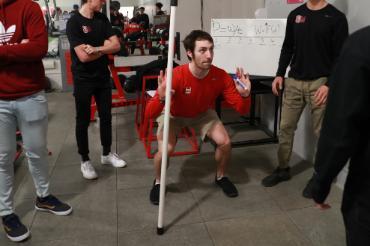
June 2019
Kinesiology Newsletter - June 2019
Introduction from the Chair
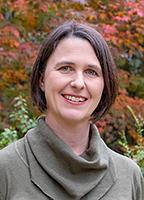
As we move forward through the summer and towards a new academic year in September, we will be focusing on some specific areas of growth. Curriculum is always on our minds, and revisions to the undergraduate program will continue to progress; stakeholders are being consulted to make sure that these changes are carried out with intention and in support of our graduate profile. We have recently received accreditation for a Master’s of Science in Kinesiology and will be admitting graduate students to start in Fall 2020. These students will have an opportunity to complete interdisciplinary coursework and follow their passion towards research or clinical pursuits. As we prepare for the growth in our research platform, we have envisioned a mobile solution to laboratory and equipment demands. The mobile lab will allow us to engage with the greater Seattle University community and expand the capacity of our research to the actual field. We are excited about this new opportunity and will be progressing our support campaign in the coming months.
We take our motto (“exercise for life, exercise for everyone”) and our alignment with the SU mission seriously. Every change that we have made has brought greater insight to our students through the evidence-based practice of exercise science; we are building leaders. The faculty have succeeded in their roles as mentors and role models, with strong contributions to research and industry. The curriculum will continue to evolve, and as we so often do when physically training, our department will constantly “tweak” the educational program to best suit our growth. Lastly, our students will benefit from even more engagement opportunities in the upcoming year. We can only be excited and energized by where we have been and where we are going!

Practical Applications Through Classroom Experiences
The Kinesiology Department strives to provide students with opportunities to apply what they learn in the classroom and expand their research experiences as they prepare to enter a variety of fields after graduation. Two innovative traditions established this past academic year are the Exercise Physiology Poster Session and the Biomechanics Fair.
Sport and Exercise Physiology Poster Sessions
Students in Sport and Exercise Physiology, taught by Professor Jacob Kysar, MS, gained experience with conducting research projects and explaining their results to peers and department members in a poster session, similar to what they would experience in a conference setting. Their presentations were judged by faculty and staff members, with the following groups receiving top honors:
Fall 2018:
- 1st: Peak Power Between Female Collegiate Softball Players and General Exercisers
- 2nd: Leg Circumference and Skinfold Measurements Effect on Relative Power Output
Spring 2019:
- 1st: Athletes and non-athletes experience high change in perceived recovery following two minutes post exercise
- 2nd: A case study: Effects of counterclockwise versus clockwise running on a track on VO2Max and velocity around curves in an endurance runner
Professor Kysar says “There is nothing that envelops the exercise physiology experience quite like the research poster session. It challenges the whole person to generate a testable question, develop a sense of empathy for the participant, and integrate earned knowledge into a novel piece of intellectual achievement.”
Biomechanics Fair – Winter 2019
As a culminating project in Dr. Shultz’s Biomechanics class, students led 10-minute interactive presentations of biomechanics principles for high school students from Rainier Beach High School. Presentations covered a variety of topics including experimenting with throwing softballs with the non-dominant arm and altering starting stance to improve height with vertical jumps. All presentations were reviewed by faculty, staff, and visiting high school students. One of the students, David Mickey ’19, says: “Starting from the very first group, the energy that was brought by the high-schoolers was that of genuine interest and engagement (along with a little pent up energy). That energy seemed to be infectious, and from minute one the Fair was exciting, fun, and extremely engaging. The students were able to learn some standard, but crucial concepts of biomechanics, and see those concepts in action that they could get involved with. The Seattle U students were having fun, laughing, and getting into the stations just as much as the high-schoolers. Overall, the Biomechanics Fair seemed to be a total success from minute one, and I thoroughly enjoyed the entire process.”
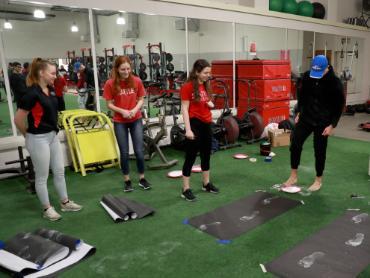

Local Conference Participation
Students had opportunities to engage with professional communities this year, including the American College of Sports Medicine (ACSM) Northwest Annual Meeting in Bend, OR, and the North West Student Sport & Exercise Psychology Symposium in Bellingham, WA.
ACSM Northwest Annual Meeting
Jacob Kysar, M.S. (Kinesiology Department Instructor), Sean Machak, M.A. (Kinesiology Department Lab Supervisor), and eight students from the Kinesiology Department traveled to Bend, OR for the American College of Sports Medicine Northwest Annual Meeting on March 1st and 2nd. The theme of this years’ conference was ‘Innovation, Application and Future of Physical Activity, Exercise and Sport.’ The group networked with both current and new colleagues and supported their collaborative research with the University of Oregon that is examining cardiopulmonary physiology. In addition to attending a breadth of academic presentations, the group culminated this experience by hosting a departmental event where attendees shared the knowledge they gained with students who were not able to attend. Professor Kysar says: “For the first time, SU was able to send a team of dedicated students and faculty to Bend where we learned the inner workings of thermoregulation, fermentation, and the microbiome; importantly, we learned that we are family.” One of the students that attended the conference, Monet Kumazawa ’20, said: “Attending ACSMNW offered me direct insight into the research and presentation environment of our growing Kinesiology field. To see/hear pioneering members of the field was inspiring, motivating, and fueled my interest for what I am studying. Spending time together with folks from the SPEX family was wonderful and memories we made together will be a big takeaway from my time at SU.”
North West Student Sport & Exercise Psychology Symposium
Under the advisement of Erica Rauff, PhD, two undergraduate students from the Kinesiology Department, Ella Fisher ‘19 and Monet Kumazawa ’20, gave an oral presentation titled "The Relationship between Physical Activity Knowledge, Barriers, and Exercise Behavior in First Year Undergraduate Students" on April 13th at the North West Student Sport & Exercise Psychology Symposium in Bellingham, Washington. When asked about her conference experience, Ella said: “Assisting in a research project is something I never imagined myself doing in my college career. However, it turned out to be one of the best decisions I made in shaping my academic experience at Seattle University. Doing an independent study and working closely with Dr. Rauff to develop a research study allowed me to see all the steps that go into doing research. I was fortunate enough to be involved in almost every step which gave me a huge appreciation for the research field. Being able to present research, on a topic I am interested in, at an academic conference really tied everything together for me. It was a lot more work than I had expected, however one of the most rewarding experiences I have had.” Dr. Rauff says: “One of the things I love about my job is having the opportunity to mentor students and watch them take all the key concepts they have learned in the classroom and apply it in a research setting. The students worked hard to develop a research question, analyze and interpret the data, and then synthesize everything into a presentation. The students gave an outstanding presentation to a room filled with professionals, graduate students, and undergraduate students. This was an amazing opportunity for the students and the skills they gained from this experience are invaluable. I encourage our current students to seek similar opportunities and explore ways to get more involved with research that faculty in our department are conducting.”
Ella and Monet earned a Student Research Award from the College of Arts and Sciences and also presented at the Seattle University Undergraduate Research Association conference held on May 31st.
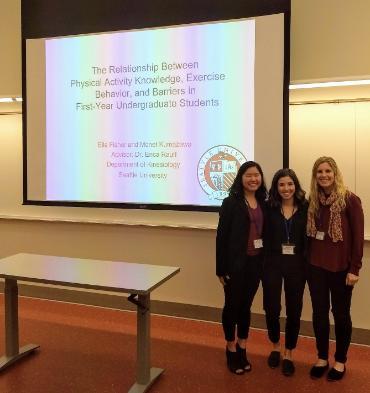
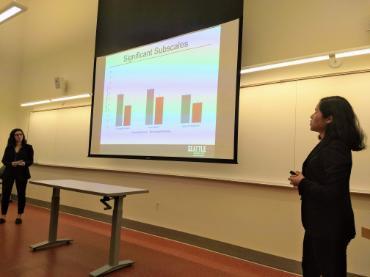

Kinesiology Student Groups
The Kinesiology Club and Exercise is Medicine groups enjoyed an active year with several highlights and accomplishments:
Kinesiology Club
The Kinesiology Club is in its second year of being a registered club at Seattle University. Its mission is to provide opportunities for connecting members with outside resources to further their education and career goals, raise awareness of the field of sport and exercise science, and bring students from the Kinesiology Department together. The club’s accomplishments from the past year included:
- Organizing the opportunity for eight students to travel to Bend, OR for the American College of Sports Medicine Northwest Annual Meeting on March 1stand 2nd.
- Collaborating with the Redhawk Fitness Center to participate in group fitness classes.
- Coordinating a guest lecture featuring a Sports Dietician from the University of Washington.
Current students interested in learning more about the Kinesiology Club can join through their ConnectSU accounts.
Exercise Is Medicine
The goal of Exercise is Medicine on campus is to increase awareness of physical activity and its associated health benefits in the Seattle University community. Exercise is Medicine also encourages the health center and CAPS to discuss physical activity and suggest students engage in physical activity as a way to improve their physical and psychological health. We currently have 8 student leaders who have been enthusiastically promoting this initiative. Some of the activities they have achieved this year included:
- Designing materials that were placed around campus encouraging students to be physically active.
- Creating informational pamphlets for the student health center and CAPS regarding the physical and psychological health benefits of physical activity.
- Planning an Exercise is Medicine Day that included a one mile walk on campus followed by 20 minutes of mindful yoga.
The students have decided to officially register as a club for the next academic year and they hope to gain members outside of Kinesiology to increase the awareness of this initiative. They are excited to continuing planning events that encourage all members of the SU community to be physically active!
When asked about her participation, Lindsey Yee ’20 says: “My experience with EIM has been rewarding because I was given the chance to bring awareness to the Seattle U community of the benefits of physical activity. I have learned that basic activities can benefit my health for the long term and want to spread the same message to our community. I became involved because I felt that students at Seattle University needed to be aware that exercise or physical activity is not as intimidating as it may seem. I am excited for what the future has to offer from EIM.” Another student leader, Jordan Berke ’20, says: “Exercise is Medicine On Campus opened my eyes to engaging with the Seattle U community as a whole. It was extremely rewarding to provide information for those who needed it most about movement and exercise. Even something as simple as taking a few minute stretch break can have a myriad of benefits! I'm excited about the future of EIMOC at Seattle University and the new creative ways to inform and engage SU!”

Faculty Spotlights
Erica Rauff, PhD had a paper accepted for publication. The title of the paper is "Compendium of Health and Wellness Coaching: 2019 Addendum" and it is being published in the American Journal of Lifestyle Medicine. The co-authors that worked on this paper with Dr. Rauff are as follows: Gary Sforzo, Miranda Kaye, Sebastian Harenberg, Kyle Costello, Joel Edman, Laura Kuo, Beth Frates, & Margaret Moore.
Jacob Kysar, MS published an article in Gait & Posture, Kysar, J. E. & Dalton B. H. (2019). Static monocular visual cues can decrease the vestibular-evoked balance response at low frequencies, 69, 162-168. This work was aimed at examining how visual asymmetries may alter one’s ability to maintain standing balance.
Douglas Berninger, M.Ed., CSCS, *D, USAW-2 (Kinesiology Department) taught a National Strength and Conditioning (NSCA) Tactical Strength and Conditioning (TSAC) Practitioner's course at Joint-Base Lewis McChord (JBLM) from May 13th – May 17th to about 25 Army Non-Commissioned Officers (NCOs) who will then take that information back to their team to begin using proper training practices.
Sarah Shultz, PhD, has published 7 articles during this academic year: four articles focused on physical function in children with obesity, 2 articles addressed community engagement with STEM (and particularly the sub-discipline of biomechanics), and one article examined physical activity modes in women of different ethnicities. The work involved collaboration with colleagues from Belgium, Australia, New Zealand, and other US universities.
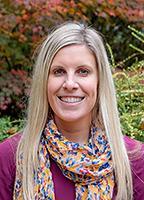
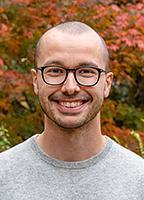
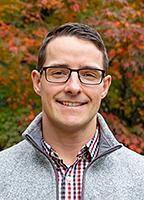
Make a Gift to Kinesiology
Designate your donation to the program by entering "Kinesiology" in the comments box.
